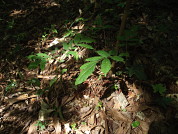Survival and growth of a timber tree under different canopy coverages in the Atlantic Forest, Misiones, Argentina
DOI:
https://doi.org/10.25260/EA.19.29.1.0.779Abstract
The natural dynamic of the rainforest generates changes in the canopy coverage and, consequently, in the quality and quantity of light that reaches the understory. Similar effects can be achieved by the anthropogenic selective extraction of trees. The microsites produced by the disturbances represent a continuum of environmental conditions that ensures the coexistence of many species. The knowledge of the requirements of the species and the evaluation of the optimal microenvironments to plant growth are useful to build tools to restore degraded areas. We worked in a native rainforest in San Antonio, Misiones, Argentina, focused in a species that has high timber and ecological value: Cabralea canjerana (Vell.) Mart. (cancharana). The aim was to evaluate the establishment of cancharana under different coverage conditions. Two experiments were carried out: a pot experiment in which survivor and growth under two extreme natural coverage were evaluated, and a field experiment in which cancharana was planted in a gradient of coverage produced by natural gaps. In both experiments, more than 90% of the cancharana plants were initially established in a wide gradient of coverage. In the pot experiment, plants without forest coverage (full sun) were damaged by the frost in winter. Four years after the plantation, 70% of the plants survived in the field experiment and mortality was observed mostly in microenvironments with lower light incidence. We conclude that cancharana can establish and survive in many microenvironmental conditions within the rainforest, it acclimates in few months to sudden changes in coverage and, one year after planting, its growth arises with higher availability of light. The species tolerates sudden changes in coverage, therefore the remove of the understory or gap opening stimulate cancharana growth.
https://doi.org/10.25260/EA.19.29.1.0.779
References
Amir, A. A. 2012. Canopy gaps and the natural regeneration of Matang mangroves. Forest Ecology and Management 269:60-67.
Ashton, P. M. S., C. V. S. Gunatilleke, I. A. U. N. Gunatilleke, y S. Journal. 1995. Seedling Survival and Growth of Four Shorea Species in a Sri Lankan Rainforest. Journal of Tropical Ecology 11:263-279.
Di Bitetti, M. ., G. Placci, y L. A. Dietz. 2003. Una Visión de Biodiversidad para la Ecorregión del Bosque Atlántico del Alto Paraná: Diseño de Paisaje para la Conservación de la Biodiversidad y prioridades para las acciones de conservación. World Wildlife Fund, Washington.
Cargnelutti Filho, A., M. M. Araujo, E. Gasparin, y A. L. de Avila. 2012. Dimensionamento amostral para avaliação de altura e diâmetro de mudas de Cabralea canjerana. Ciência Rural 42:1204-1211.
Carpenedo Aimi, S. 2014. Tecnologia de sementes e crecimiento inicial de mudas de Cabralea canjerana (vell.) Mart.:110.
Carvalho, P. E. R. 1996. Influência da intensidade luminosa e do substrato no crescimento , no conteúdo de clorofila e na fotossíntese de cabralea canjerana ( vell .) Mart. Subsp. canjerana, Calophyllum basil

Downloads
Published
How to Cite
Issue
Section
License
Copyright (c) 2019 Ana P. Moretti, Flavia Y. Olguin, Martín A. Pinazo, Fermín Gortari, José Vera Bahima, Corina Graciano

This work is licensed under a Creative Commons Attribution 3.0 Unported License.
Authors retain their rights as follows: 1) by granting the journal the right to its first publication, and 2) by registering the published article with a Creative Commons Attribution License (CC-BY 4.0), which allows authors and third parties to view and use it as long as they clearly mention its origin (citation or reference, including authorship and first publication in this journal). Authors can make other non-exclusive distribution agreements as long as they clearly indicate their origin and are encouraged to widely share and disseminate the published version of their work.


